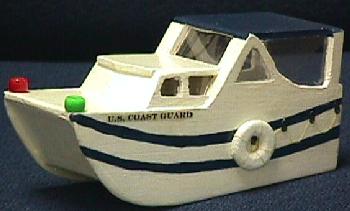| Raingutter Boat Racing - |
How To Make A Fast Regatta Boat |
Accessories
Anything you add to your boat that did not come from your kit or is not
part of your hull is an accessory. However, accessories may also
be parts you cut from a foam block or sheet of wood to build a cabin or life ring. Unlike
the hull, your boat doesn't rely on these parts to stay afloat during a
race. Accessories help make your boat look like a real one or achieve some
artistic goal.
| Attach all accessories firmly to your boat, unless you know it is legal and have a good reason not to. |
|---|
|
It may make sense to attach some accessories before finishing the body and some after. You may want some parts treated with wood putty, sealer, paint or plastic coating just like the hull. Others may not need it. Finish figures and ornaments separately then attach to the hull. Water-proof decals, interior gauges, windows and flags with a polyurethane coating.
Decals are some of the most widely used accessories. There are at least two problems with buying them - 1) It's very hard to find what you need and 2) when you do, it's expensive! So, here's how to make your own at practically no cost.
Look in boat magazines or if you're artistic, draw your own with color pencils or water color. We found some small patches and achievement pin pictures in our club's supply catalog. Cut out what you need with a good pair of scissors or a sharp hobby knife (put a clip board or something solid behind your work).
Glue the cutout where you want it. Coat your homemade "decal" with an acrylic clear coat varnish or a little acrylic sanding sealer. This seals the surface of the cutout - other clear coatings (like polyurethane) might cause the color from the backside of the cutout to show through. Once it is dry, you can coat it with whatever type of clear finish you use on your hull. The more layers of clear coat, the deeper the shine and less you will notice the slight edge of the cutout.
Transparency film is excellent for making windows, and portholes. Cut it or bend it to shape. Score it for corners. Tabs on the film and slots in the boat help hold it in place. It can even be hot glue "gunned".
To enclose an area with transparency windows, first finish the interior, exterior and the roof parts separately except where they join. Test fit the parts. Correcting gaps or mismatches will be hard once the windows are in. Tab or glue the windows in place on the inside of the cabin before putting the roof on. That way, excess hot glue can be hidden from view.
Cut and assemble chairs and steering wheels from thin slabs of wood or foam. See the paragraphs above about decals to make dials and controls on control consoles.
Clay can be sculpted, painted and coated with liquid plastic for deck
figures or structures. It is not immune to damage, so use clay figures for
interiors or places not likely to be touched. Snoopy looks very relaxed
fishing off the deck in a Hawaiian shirt and sunglasses. What's that root
beer mug doing there? He's fish'n for "cat" fish, of course!
For lighter more durable figures, use Crayolla Model Magic(tm) - yes,
you really can make figures like the ones shown on the package - you don't
need to be a pro! It's like a rubber putty that air-dries. It is also very
light and clean. If you get the assortment pack you can mix colors or make
a nice marbled effect. It can be painted and covered with liquid plastic
and is fairly durable. It's the best-behaved modeling compound ever; you'll
want to use it in other creations too. The package says not to try storing
it, but it can be kept for a couple of months in airtight zip-lock bags
with the air squeezed out.
Carving isn't the only way to build figures from wood. Engines can be
built up easily from small wood blocks. Of course, engines and other parts
can often be used from plastic model kits - just check your rules.
Then there's molding figures. Hobby stores carry supplies so you can
make rubber (latex) or plaster molds. Cast plaster of paris, spackle or wax
in a rubber or plastic mold. Spackle needs a thin layer of vaseline in the
mold as a separator or it sticks to the mold. Cast rubber in a
plaster mold with a vaseline or oil-based separator.
We made castings of spackle in vaseline coated molds for my daughter's
boat she called, "Under the Sea". There were two sea horses, a starfish and
mermaid. The shell was hand formed from spackle to fit the front of the
sail. The boat is very light!
Accessorate Your Theme - Examples
- A lifeboat. You might whittle some oars, a floatation ring, etc. Use thread for rope. It could have benches or another type of chair. Don't forget to paint it yellow.
- A houseboat. Frame a "house" in front of the sail with balsa panels. Large transparency film windows let your friends look in to see who's there. Maybe it's Mickey and Minnie on vacation.
| Raingutter Boat Racing - |
How To Make A Fast Regatta Boat |
| Copyright © 1997, 2000, 2001, 2004 by Michael Lastufka, All rights reserved worldwide. |
